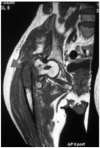Intraosseous synovial sarcoma of the proximal femur: Case report
- PMID: 25279044
- PMCID: PMC4093584
- DOI: 10.5704/MOJ.1203.003
Intraosseous synovial sarcoma of the proximal femur: Case report
Abstract
Abstract: Synovial sarcoma is primarily a soft tissue malignancy that most often affects adolescents and young adults. It very rarely presents as a primary bone tumour and has only been reported in nine other cases to date. We report a case of primary synovial sarcoma arising from the proximal femur in a 57-year-old man.
Key words: Synovial sarcoma, primary bone tumour.
Figures




References
-
- Weiss WS, Goldblum JR, Enzinger FM. Enzinger and Weiss' soft tissue tumors.5th ed. Philadelphia: Mosby Elsevier; 2008.
-
- Fletcher CDM, Unni KK, Mertens F. World Health Organization., International Agency for Research on Cancer. Pathology and genetics of tumours of soft tissue and bone. Lyon: IARC Press; 2002.
-
- Cohen IJ, Issakov J, Avigad S, Stark B, Meller I, Zaizov R. Synovial sarcoma of bone delineated by spectral karyotyping. Lancet. 1997;350(9092):1679–1680. - PubMed
-
- Hiraga H, Nojima T, Isu K, Yamashiro K, Yamawaki S, Nagashima K. Histological and molecular evidence of synovial sarcoma of bone. A case report. J Bone Joint Surg [AM] 1999;81(4):558–563. - PubMed
LinkOut - more resources
Full Text Sources
